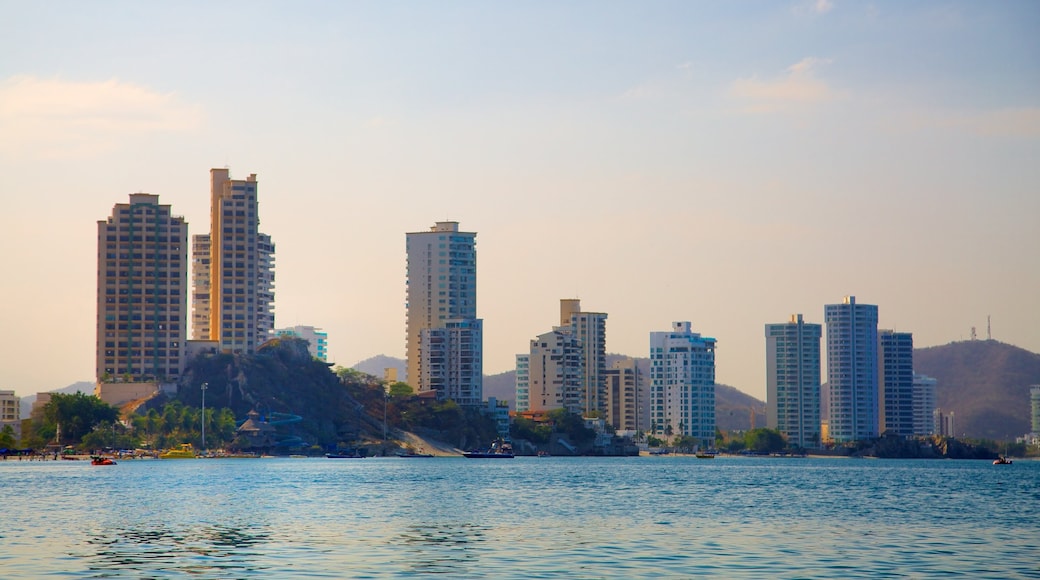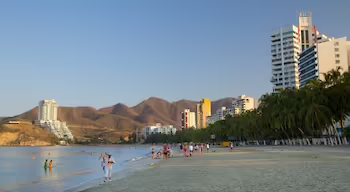The oldest surviving city in Colombia and the second oldest in South America, Santa Marta is a postcard-worthy destination flanked by the pristine beaches of the Caribbean and the snow-capped Sierra Nevada mountains. Founded in 1525, the city’s Historic Center is dotted with picturesque plazas, centuries-old churches, and colorful colonial buildings turned into hostels and hotels. During the day, visitors enjoy swimming, snorkeling, and diving at the 3 main beaches near the city, or venturing into the tropical rainforest of Tayrona National Park. After the sun goes down, Santa Marta comes alive at the restaurants, bars, and nightclubs around historic Los Novios Park and in the beachside neighborhoods of Rodadero and Taganga.
Areas & Neighborhoods in Santa Marta
Historic Center — Declared a National Monument in 1963, the Historic Center of Santa Marta is the perfect place to take an afternoon stroll. Begin with a walk along charming Paseo Bastidas promenade, and then make your way into the landscaped gardens of Simon Bolivar Park. As you continue on, pass by cultural and historic sites like the Tairona Gold Museum, the San Juan Cultural Center, the Madame Augustine Archaeological Museum, and the 18th-century Santa Marta Cathedral. Around the commercial hub of San Francisco Plaza, find a selection of boutiques and shopping malls, while the area around Los Novios Park is full of restaurants, bars, and cafes. In the southeast end of the district sits San Miguel Park, an urban oasis with picnic tables, flower stalls, and recreation areas for all ages.
Rodadero Playa — Roughly 4 miles (6 km) south of the Historic Center, Rodadero Beach is one of the most visited spots in the region. Lively and dynamic, tourists come here in the day to enjoy a range of activities, from swimming and sailing to snorkeling and scuba diving to haggling with vendors over food and drinks. Once the sun goes down, visitors stick around to take advantage of an energetic nightlife scene, with plenty of bars, restaurants, and music venues to be found along the 4 main streets that run parallel to the beach. Of the area’s other attractions, a favorite includes Marine World Aquarium, with interactive swimming pools, shark feedings, and educational exhibits.
Playa Blanca — Nestled in the rocky cliffs separating the Historic Center from Rodadero, Playa Blanca is accessible only by boat from either of the 2 areas. Cleaner and more secluded than Rodadero but still typically crowded, it’s best to get here early to reserve a sun tent and chairs. During your visit, you can relax on the warm sand, go swimming in the crystal-blue water, and dine on a lunch of fresh seafood from a beachside hut. Another short journey by boat can bring you to the Rodadero Sea Aquarium, an attraction housing more than 800 animals such as dolphins, sea lions, sharks, turtles, crustaceans, and fish.
Taganga — Located 3 miles (5 km) north of the Historic Center, Taganga is a former fishing village with a small but beautiful beach, affordable hostels that attract backpackers, and a surprising selection of bars of nightclubs along its narrow, dusty roads. You can come here to swim, snorkel, or sunbathe, and the destination is especially popular among divers. The city also serves as the gateway to Tayrona National Park, a large protected area of forested trails and palm tree-shaded coves.
Tayrona National Park — A magical slice of Colombia’s Caribbean coast, Tayrona National Park covers 58 square miles (150 sq km) in the foothills of the Sierra Nevada. Home to flourishing hiking trails, a variety of wildlife, and ancient archaeological ruins, the park is best known for its collection of gorgeous beaches that sit along sparkling lagoons. On a day trip from Santa Marta, you can visit some of the most stunning of these beaches, including Playa Cristal, Cabo San Juan, Arrecifes, and Cañaveral. From Cabo San Juan, you can also hike 1.5 miles (2.4 km) up a steep pathway to reach El Pueblito, the site of pre-Hispanic ruins set in the tranquil surroundings of the jungle.
What to See in Santa Marta
For a lovely view overlooking Santa Marta, head to Ziruma Hill just east of Playa Blanca. A 35-minute walk or 10-minute drive from the Historic Center will bring you to a dirt pathway at the bottom of the hill on Avenida Hernandez Pardo. Take a right and begin your hike up the hill for roughly a half-mile (750 m). Upon reaching the top of the tree-covered mountain, you’re met by sprawling views of Santa Marta Bay and Rodadero Beach.
Sightseeing in Santa Marta
Explore the must-see sites of Santa Marta in just a few hours. With a local leading the way, immerse yourself in the city’s rich history as you travel through the well-preserved Historic Center. In the glint of the midday sun, admire the Spanish influences that can be seen throughout the district’s colonial architecture. Stop to see monuments dedicated to famous figures like city founder Rodrigo de Bastidas before making your way to Santa Marta Cathedral, one of the oldest churches in South America. As the sun begins to set over the romantic city, cap off your tour with a visit to Quinta de San Pedro Alejandro, the exquisite final home of 18th-century revolutionary leader Simon Bolivar, which now boasts a botanical garden and museum.
Once you’ve explored Santa Marta to your heart’s content, head out of town to experience the spectacular coastline to the north and south of the city. In Tayrona National Park, take a scenic cruise to idyllic Playa Cristal, bask in the breathtaking beauty of Cañaveral Beach, or walk among the enormous egg-shaped boulders at Arrecifes. In Playa Blanca to the south of Santa Marta, enjoy a day of aquatic delight with a morning spent snorkeling followed by a trip to meet the friendly dolphins and sea lions at Rodadero Aquarium. Further south in Rodadero Beach itself, you can soak in a spirited atmosphere of Latin eateries, seaside bars, and late-night disco clubs.















